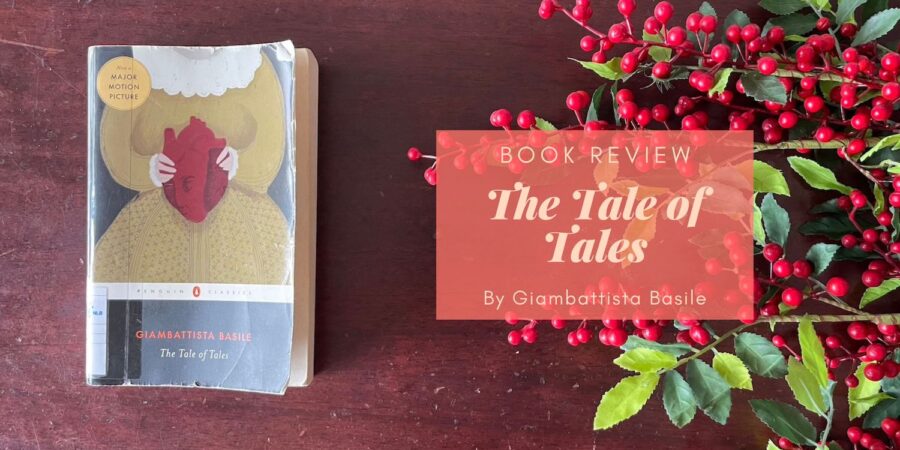I first heard about Giambattista Basile and his work The Tale of Tales while reading The Fairy Tellers by Nicholas Jubber. Since I’ve never met a fairy tale I didn’t like, and since I’ve never read anything from The Tale of Tales, I decided to seek out a copy to read.
And wow, it’s definitely original! But let me backtrack and start with the story; while The Tale of Tales is a collection of fairy tales, it’s held together by a story about a princess, Zoza, who, never being able to laugh, ended up being cursed by an old woman (because she laughed at the old woman when she fell). Zoza searches for her prince, who’s under a spell and can only be awoken by a pitcher of tears. Unfortunately, crying is hard work and when Zoza is just two tears away from filling the pitcher, she falls asleep and a slave girl steals the pitcher, fills it, and wakes the prince. It’s this slave girl, who demands to hear stories or she will kill the baby she’s pregnant with and that starts the practice of ten stories a day.
And these are very unusual stories indeed. Some of them will seem recognisable; Cenerentola, for example, resembles Cinderella and Petrosinella resembles Rapunzel, for example. But with fifty tales, many are fresh and original. Some that stick out to me include:
- The ugly old woman who tricked a king into sleeping with her and got thrown out a window (and then was turned into a beautiful maiden by fairies). She tells her jealous sister that her beauty is because she got skinned, to rather disastrous results.
- Renza, who was enclosed in a tower because of a prophecy that she would die from a big bone. She escapes using a bone a dog brought to her by a dog when she falls in love with a prince but alas, there are no happy endings here.
- A peasant girl who becomes the Queen but due to her rudeness to the fairy who brought her up, has her face turned into one of a goat (the whole point of this story: don’t be rude).
- The girl who literally made her own husband out of sugar paste
- Sapia is tasked with teaching the prince how to read. When her slap humiliates him, he actually does learn his letters and intends to marry her to take his revenge for the slap. Unfortunately for him, Sapia remains two steps ahead.
Apart from the stories themselves, I found the language in this book to very unique. Even stories that are familiar were made fresh through the way they were told. The Tale of Tales was written in Neapolitan and while I’m not sure if it’s a feature of the dialect, I found the descriptions to be incredible. Even the descriptions of nightfall were unique, for example:
- “In the morning – when Night’s shadows, chased by the Sun’s cops, were evicted from the town.”
- “when the Sun sets the stubble of the aerial fields on fire.”
- “They all laughed so hard at the humiliation of the shameless buddy that they didn’t realise the Sun had been too extravagant with its light and gone bankrupt and, after putting its golden keys under the door, escaped to safety.”
One note about the language for parents: The Tale of Tales is more explicit about sex than other fairy tales; I mean, yes in others we see stories about babies coming out of wedlock (ahem, sleeping beauty), but here, there are fanciful descriptions. It’s all described in metaphors and allusions, but you may not want to give this book to young children without vetting it to make sure your child can handle it. I say this because the subtitle of the book is “Entertainment for Little Ones”.
The Penguin Classics edition I read contains a foreword, a translator’s note, and an introduction. Each of the stories are also generously annotated, but I would personally advise you to ignore all these in the first reading. This edition is great for rereading and studying, and I would want to reread this one day, but I think it’s best to just enjoy the tales for what they are. I read the translator’s note and introduction last and didn’t think I suffered for it. I also skipped the ecologues, which are essentially dialogues between two members of the court and serve to divide the days in the story, because they didn’t interest me. I did read that these stories are literary fairy tales, and many of them parody works that were popular then, but I think for enjoyment, you can just focus on the tales.
Overall, this is a unique and fun collection of tales. I don’t think it will be for everybody, because the language might be a bit of a turnoff, but I had a lot of fun with this collection and would definitely like to revisit it in the future.

I might like this. Looks like these are dark fairy tales, sure not for kids. That pitcher of tears and making husband out of sugar paste is definitely unique.
Definitely not for kids! And yeah, a lot of the fairy tales are unique, I really liked that!
Have you seen film Tale of Tales (2015) with international stars? I recommend. It is a beautiful film, and the final part is especially hilarious.
Ooooh, I have not but I had fun with this book so I’ll try to find it, thanks for the recommendation!